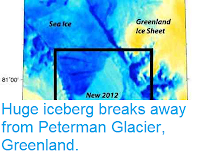Dust storms have been reported in Greenland for over a century, particularly at high altitudes, but the source the dust in such storms has not always been clear. For a long time this dust was thought to have come from dried lake-beds, river valleys or coastal areas, but in the last decade it has been realised that the major source of this dust is glaciers, which grind fine silt from rocks as they flow. However proving this theory has been difficult, as these dust storms are infrequent, and their origin has not been observed.
Satellite image of dust being blown from a glacier in Greenland on 29 September 2018. Earth Observatory/NASA.
Then on 29 September 2018 the European Space Agency’s Sentinel-2 Satellite observed and NASA’s Terra Satellite both observed glacial dust being blown from a stream valley about 130 km to the northwest of the village of Ittoqqortoomiit on the east coast of Greenland. The stream carries water from glaciers higher in the valley to the Scoresby Sound and on to the sea. In September a low pressure system passing across the region caused temperatures to fall, temporarily halting melting from the glaciers, and causing the stream to stop flowing. Over the next few days the valley dried out, and then rising winds on 29 September began to raise dust from the stream valley, something which persisted for several days.
See also...
Then on 29 September 2018 the European Space Agency’s Sentinel-2 Satellite observed and NASA’s Terra Satellite both observed glacial dust being blown from a stream valley about 130 km to the northwest of the village of Ittoqqortoomiit on the east coast of Greenland. The stream carries water from glaciers higher in the valley to the Scoresby Sound and on to the sea. In September a low pressure system passing across the region caused temperatures to fall, temporarily halting melting from the glaciers, and causing the stream to stop flowing. Over the next few days the valley dried out, and then rising winds on 29 September began to raise dust from the stream valley, something which persisted for several days.
The approximate location of the 29 September Greenland dust storm. Google Maps.
See also...
Follow Sciency Thoughts on Facebook.






